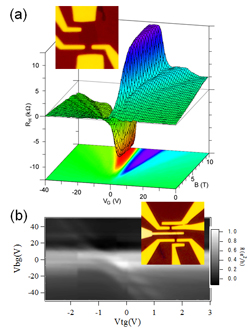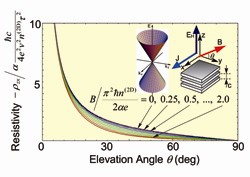Magnetotransport of Dirac Fermions:
Graphene and Organic Conductors
Osada Group
Magnetotransport features of massless Dirac fermions have been studied in two low-dimensional systems; graphene and layered organic conductors.

Fig.1. (a) Half-integer quantum Hall effect ingraphene. Inset: Microscope image of graphene FETdevice. (b) Top- and back-gate voltage dependenceof Hall resistance across the top-gated region. Inset:top-gated graphene FET device.

Fig.2. Interlayer Hall resistivity rzx calculatedassuming multilayer Dirac fermion system withincoherent interlayer coupling.
One of the most remarkable phenomena observed in graphene is the half-integer quantum Hall effect (Fig.1(a)). It originates from the nature of two-dimensional (2D) massless Dirac fermions. In Hall-bar-type devices, transport features of quantum Hall state are well described by the edge channel picture by Landauer and Buttiker. In order to study edge channels in graphene as a bipolar quantum Hall system, we have performed magnetotransport measurements in the graphene FET device with the additional top gate electrode that controls local carrier density. Samples have been prepared using mechanical exfoliation and electron-beam lithography technique. The Hall resistance across the top-gated region is fractionally quantized as expected by the Landauer-Buttiker picture (Fig. 1(b)). By reversing magnetic field orientation, we have observed the breaking of electron-hole symmetry of edge channel transport in graphene.
Recently, it has been pointed out that several organic conductors, α-(BEDT-TTF)2I3,α-(BEDT-STF)2I3, etc. are multilayer Dirac fermion systems, which consist of parallel stacked conducting layers. The electron system of each layer is a 2D massless Dirac fermion system with in-plane anisotropy, and the Fermi level is located at the Dirac point resulting in zero-gap structure. On the other hand, unusual magnetotransport behaviors have been reported in these compounds; saturation of in-plane resistance (ρxx), local maxima of in-plane Hall resistance (ρyx), negative interlayer magnetoresistance (ρzz), and anomalous angle-dependence of interlayer Hall resistance (ρzx) obeying the "cotθ-law". The origins of these phenomena have been open questions for a long time. Based on the multilayer Dirac fermion model, we have theoretically reconsidered the mysterious magnetotransport features. We consider the quantum limit where only the n=0 Landau level exists at the Fermi level. In the massless Dirac fermion system with the Fermi level located at the Dirac point, the quantum limit is easily reached even in low magnetic fields. We employ the perturbation method called the "tunneling picture", which treats interlayer coupling as a perturbation. The conductivity is expanded into a power series of the interlayer transfer energy tc. At the limit of weak interlayer coupling, the lowest order term of tc gives the dominant contribution to the conductivity. We have evaluated the lowest order term for all elements of conductivity tensor. By calculating the inverse tensor of conductivity, we have successfully obtained the approximate formulae of all elements of resistivity tensor. They reproduce all of the observed behaviors qualitatively, particularly, negative interlayer magnetoresistance ρzz~1/|Bz| and anomalous angle-dependence of interlayer Hall resistance ρzx~|By/Bz|=cotθ. They are characteristic phenomena in multilayer Dirac fermion systems at the quantum limit. The present result strongly suggests that massless Dirac fermions really exist in several organic conductors.
